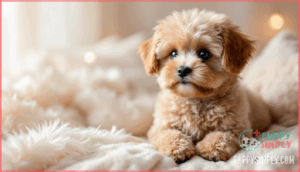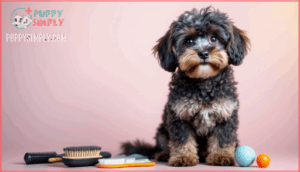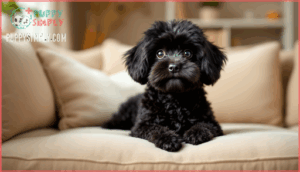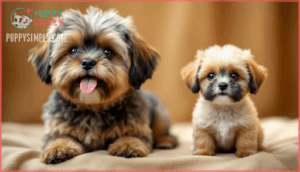This site is supported by our readers. We may earn a commission, at no cost to you, if you purchase through links.

This unique blend of bold personality and devoted companionship comes from their Shih Tzu and Poodle lineage, creating a dog that conforms to your lifestyle rather than demanding you conform to theirs.
What makes Shih Poos particularly compelling for prospective owners isn’t just their hypoallergenic coat or teddy bear appearance—it’s their forgiving temperament and moderate needs that make them manageable for first-time dog owners while still offering the intelligence and loyalty experienced owners appreciate.
Table Of Contents
- Key Takeaways
- What is a Shih Poo Dog?
- Shih Poo Appearance and Size
- Shih Poo Temperament and Personality
- Shih Poo Health and Common Issues
- Grooming and Coat Maintenance Tips
- Exercise and Living Requirements
- Feeding and Nutrition Guidelines
- Finding and Choosing a Shih Poo
- Frequently Asked Questions (FAQs)
- Conclusion
Key Takeaways
- Shih Poos blend Shih Tzu loyalty with Poodle intelligence, creating a forgiving temperament that works well for first-time owners while still engaging experienced handlers through their sharp minds and adaptable nature.
- Their low-shedding, hypoallergenic-leaning coats aren’t maintenance-free—expect brushing three to four times weekly and professional grooming every four to six weeks to prevent matting and keep that teddy bear look intact.
- These dogs inherit moderate health risks from both parent breeds, particularly hip dysplasia (22% from Shih Tzus), patellar luxation, eye problems, and periodontal disease, making regular vet checkups and preventative care essential for their 10-18 year lifespan.
- Despite their small size and 30-minute daily exercise needs, Shih Poos form intensely loyal bonds and struggle with separation anxiety, thriving best in homes where they won’t face long stretches of isolation.
What is a Shih Poo Dog?
If you’ve ever wondered what happens when you cross two of the most beloved toy breeds, you’re about to find out. The Shih Poo brings together the best traits of its parent breeds in one compact, lovable package.
Let’s break down what makes this designer dog so special, starting with where it comes from and who it’s perfect for.
Shih Tzu and Poodle Mix Origins
The Shih Poo didn’t just happen by accident—this designer dog was intentionally bred to combine the best of two beloved toy breeds, the affectionate Shih Tzu and the sharp-minded Toy Poodle.
This crossbreed emerged from hybrid breeding programs aiming to capture the Shih Tzu’s loyal, loving temperament alongside the Poodle’s low-shedding coat and intelligence. Each parent breed brings distinct genetic heritage to the mix, creating a dog that’s both cuddly and clever—perfect for anyone wanting companionship without the constant vacuuming.
Shih Poo Breed Recognition Status
Despite how popular the ShihPoo has become, you won’t find it recognized by major kennel clubs like the American Kennel Club (AKC), United Kennel Club (UKC), or Fédération Cynologique Internationale (FCI). That’s because these organizations only acknowledge purebred dogs with established breed standards—not hybrid or designer breeds. However, alternative registries do accept mixed breed dogs:
- Designer Kennel Club (DKC) grants registration papers and pedigree documentation specifically for Shih Poos
- American Canine Hybrid Club provides official registry status for this designer breed
- Mixed-breed competitions through organizations like NASDA welcome Shih Poos for titles and events
- Community registries connect breeders and owners, though without uniform breed standards governing size or temperament
This lack of formal recognition doesn’t affect canine health or temperament—it simply means your Shih Poo can’t compete in traditional conformation shows. The registration process through designer breed organizations remains accessible for owners wanting official documentation. Owners can learn more about dog health issues to better care for their pets.
Suitability for First-Time Owners
If you’re wondering whether a Shih Poo might be right for your first dog, you’ll be glad to know this hybrid usually is more forgiving than many purebreds when dealing with rookie mistakes. Their moderate energy and adaptable nature make them excellent companion dogs for first-time owners managing apartment living.
While dog training requires patience—they can show stubborn streaks—their intelligence and eagerness to please generally outweigh the challenges, helping new pet parents build confidence.
Shih Poo Appearance and Size
When you first see a Shih Poo, it’s easy to fall head over heels for their charming looks. These little companions come in various shapes, sizes, and colors that make each one unique.
Let’s break down what you can expect regarding their physical appearance and size range.
Teddy Bear-Like Face and Build
One look at that rounded muzzle, button nose, and soft, fluffy features, and you’ll understand why everyone calls them "living teddy bears." Their compact body proportion and domed head shape give Shih Poos that irresistible charm—floppy ear placement frames their expressive eyes, while their small nose and compact build make them the perfect companion dog for cuddling.
This hypoallergenic small dog breed’s adorable facial structure demands regular dog grooming to maintain that signature teddy bear appearance.
Coat Types and Colors
Your Shih Poo’s coat is a genetic lottery ticket—some pups inherit the Poodle’s tight curls, while others land somewhere between wavy and straight, depending on which parent’s genes win out. This crossbreed’s texture variations directly impact shedding levels and your grooming routine.
Common coat characteristics include:
- Color genetics produce everything from solid blacks, browns, and creams to parti-colors with striking combinations
- Lowshedding coats marketed as hypoallergenic still require consistent brushing to prevent matting
- Texture differences mean curly-coated Shih Poos need more frequent professional dog grooming than their wavy-coated littermates
Black Shih Poo Characteristics
A black Shih Poo doesn’t just rock a solid ebony coat—this color variation comes with specific grooming considerations you’ll want to know before bringing one home. Dark fur shows less dirt but highlights skin flakes and dander more visibly.
These poodle crossbreeds benefit from hybrid vigor regardless of coat color genetics, though puppy socialization matters more than pigmentation for temperament development in small dog breeds like this hypoallergenic favorite.
Shih Poo Full Grown Vs. Teacup Size
Full-grown Shih Poos tip the scales at 8–18 pounds and stand 8–15 inches tall, but "teacup" versions—bred intentionally smaller—come with health trade-offs that most veterinarians don’t recommend. These miniaturized crossbreeds face higher risks of fragile bones, hypoglycemia, and organ complications during growth stages—weight factors that responsible breeders avoid manipulating. Standard-sized small dog breeds like hypoallergenic dogs usually live longer, healthier lives with fewer full-grown needs for specialized teacup care.
Size comparison realities for potential owners:
- Teacup breeding prioritizes appearance over welfare—a practice that contradicts ethical dog grooming and health standards
- Your heart might melt at a 4-pound puppy, but emergency vet bills from preventable complications won’t feel as warm
- Standard Shih Poos give you that adorable factor without gambling on your dog’s quality of life
Shih Poo Temperament and Personality
Your Shih Poo’s personality is shaped by two distinctly different parent breeds, which means you’re getting a dog that’s both brainy and affectionate. Understanding their temperament helps you know what to expect and how to bring out the best in your pup.
Let’s break down the key personality traits that define this charming little mix.
Intelligence and Trainability
Think of the Shih Poo as inheriting two very different report cards—one from a straight-A student and one from a creative free spirit who questions every rule. These intelligent dog breeds absorb canine learning quickly, but their stubborn streak means dog training methods need patience and positive reinforcement.
Without consistent socialization and engaging activities, behavioral issues like boredom or anxiety can surface. Their cognitive development thrives on mental stimulation—puzzle toys and varied routines keep their sharp minds satisfied and prevent destructive dog behavior patterns.
Affectionate and Loyal Nature
Few dogs wear their hearts on their furry sleeves quite like the Shih Poo—these little companions bond so deeply with their families that separation can feel like a personal betrayal to them.
You’ll find these loyal companions shadowing your every move, craving heartfelt connections that make them excellent emotional support animals. Their family bonds run deep, turning companion animals into velcro dogs who thrive on your presence and affection, making them ideal for anyone seeking unwavering devotion.
Shih Poos form deep bonds with their families, becoming devoted velcro dogs who crave constant companionship and thrive on affection
Socialization Needs
Without proper early socialization, your devoted Shih Poo can transform from a confident companion into a nervous pup who views strangers and new situations as potential threats rather than adventures. Effective puppy socialization shapes behavioral development through controlled human interaction and environmental adaptation—essential for canine companionship in small dog ownership.
Focus on:
- Introducing diverse people, sounds, and surfaces during critical development windows
- Arranging positive encounters with other vaccinated dogs for proper dog socialization
- Practicing reward-based dog training in various settings to build confidence
This animal behavior and training foundation prevents reactivity later.
Potential for Anxiety
Even with solid socialization, Shih Poos can still wrestle with anxiety—their sharp minds and deep attachment to their humans make them vulnerable to separation stress and environmental triggers.
Recognizing anxiety triggers early helps you implement calming techniques like crate training, puzzle toys, and gradual departures.
These stress reduction techniques support your dog’s emotional wellbeing, transforming separation anxiety from a daily battle into manageable moments through consistent stress management rooted in animal behavior and psychology.
Shih Poo Health and Common Issues
Like any mixed breed, Shih Poos can inherit health concerns from both parent breeds, and knowing what to watch for helps you catch issues early. Some conditions are minor nuisances, while others need ongoing management with your vet.
Let’s walk through the most common health challenges you might face with your Shih Poo.
Hip Dysplasia in Shih Poos
Your Shih Poo faces moderate genetic risk for hip dysplasia—about 22% from the Shih Tzu side and 12% from Poodles. This canine health issue develops when the hip joint forms incorrectly, causing discomfort and mobility trouble.
Watch for these breed-specific risks:
- Rear leg lameness or a "bunny hop" gait between 6 months and 1 year
- Reluctance to jump, climb stairs, or rise after rest
- Pain when you manipulate their hips during play
- Muscle loss around the hip area as dysplasia progresses
- Environmental triggers like overfeeding, rapid growth, or obesity worsening symptoms
Early dysplasia diagnosis through veterinary care and joint health management—including weight control, low-impact exercise, and supplements—keeps your dog comfortable. Canine orthopedics offers surgical options for severe cases. Understanding hip dysplasia causes is essential for effective prevention and management.
Patellar Luxation Concerns
While hip dysplasia affects the socket, patellar luxation happens when your Shih Poo’s kneecap slips out of its groove—a common orthopedic issue in toy breeds. You’ll notice sudden limping, a skipping gait, or your dog holding one leg up during walks.
| Grade | Symptoms | Veterinary Care Needed |
|---|---|---|
| 1 | Occasional skip, self-corrects | Monitor; joint health supplements |
| 2 | Frequent limping, manual reset | Physical therapy, weight management |
| 3 | Kneecap out most of the time | Likely canine surgery candidate |
| 4 | Permanent displacement | Immediate surgical intervention |
| All | Pain, reduced activity | Regular vet check-ups essential |
Severe cases require canine surgery to realign the joint and restore mobility. Early veterinary care and proper pet care—maintaining a lean body weight and controlled exercise—protect your dog breed from worsening symptoms.
Eye Problems and Periodontal Disease
Beyond joint issues, your Shih Poo faces significant eye problems and periodontal disease risks inherited from their Shih Tzu lineage. Studies show over 96% of Shih Tzus have at least one eye abnormality—corneal ulcers, dry eye syndrome, and cataracts can lead to vision loss without proper eye care tips.
Dental hygiene matters just as much: nearly 10% develop periodontal disease, especially after age seven. Regular vet visits and daily tooth brushing are your best defense against these Shih Poo health issues.
Lifespan and Preventative Care
Generally, your Shih Poo can enjoy 10 to 18 years with proper preventative measures and longevity factors in place. Regular health checks catch early signs of heart disease or diabetes, while vaccination schedules starting at 6–8 weeks protect against infections.
Diet planning with balanced nutrition and daily exercise prevents obesity—a lifespan killer in hypoallergenic dog breeds.
Consistent canine veterinary care and dog grooming tips for dental hygiene directly impact pet health outcomes.
Grooming and Coat Maintenance Tips
Your Shih Poo’s coat won’t take care of itself—it needs regular attention to stay soft, clean, and tangle-free. The right grooming routine keeps your dog comfortable and helps you spot potential health issues early.
Let’s break down what you need to know about brushing, professional grooming, and caring for their skin, eyes, and ears.
Brushing and Mat Prevention
Your Shih Poo’s coat won’t just brush itself—and without regular care, those soft curls can quickly turn into a tangled mess that’s uncomfortable for your pup and frustrating for you.
Brush at least three to four times weekly using a slicker brush or pin brush designed for coat detangling. These grooming tools work wonders on hair tangles, especially in high-friction areas like behind the ears and under the legs where mats form fastest.
Professional Grooming Schedule
Most groomers recommend booking your Shih Poo in for a professional trim every four to six weeks—not just for looks, but to keep their coat healthy and manageable between your at-home brushing sessions.
Regular grooming appointments tackle nail care, sanitary trims, and shedding control while preventing mats your brush might miss. Think of it as preventative maintenance—your pup stays comfortable, and you’re not wrestling with overgrown coats at home.
Skin, Eye, and Ear Care
Between grooming sessions, your Shih Poo’s skin, eyes, and ears need just as much attention as that fluffy coat—skip these areas, and you’re inviting infections, irritation, and a whole lot of vet visits. Here’s what to watch for:
- Tear stains around the eyes—wipe daily with a damp cloth to prevent buildup and eye diseases
- Facial hygiene matters—trim hair around the eyes so it doesn’t poke or collect debris
- Eye cleaning catches early signs of allergies or irritation before they escalate
- Ear mites thrive in warm, moist ears—check and clean weekly
- Skin infections from trapped moisture or allergens—monitor for redness or odor during grooming
Is The Shih Poo Hypoallergenic?
Here’s the truth about allergen reduction: Shih Poos aren’t truly hypoallergenic, but they’re about as close as you’ll get in the crossbreed world. Thanks to their poodle lineage, these dogs produce less dander and shed minimally, which means fewer pet allergy triggers floating around your home.
That said, breed sensitivity varies wildly between people—some folks react even to low-shedding breeds, while others don’t sneeze once. So, spend time with a Shih Poo before committing if allergies are a concern.
Exercise and Living Requirements
Shih Poos don’t need marathon runs, but they do need consistent movement to stay happy and healthy. Your living space matters less than you might think—these adaptable little dogs can thrive almost anywhere if their basic needs are met.
Let’s look at what your Shih Poo actually requires to feel at home.
Daily Activity and Play Needs
If you’ve got a Shih Poo at home, you might think this pint-sized pup barely needs to move—but don’t let that cuddly teddy bear appearance fool you.
They need around 30 minutes of exercise daily—think short walks, playtime routines, and indoor games that provide mental stimulation. You’ll want to mix physical activity with dog training sessions to keep their sharp minds engaged and prevent anxiety-driven behavior.
Apartment and Urban Living Suitability
Since they’re small, low-shedding, and don’t need much space, Shih Poos can thrive in apartments and city settings where square footage comes at a premium. Their intelligent nature makes apartment training straightforward, and they adapt well to urban noise levels that might spook larger breeds.
You won’t need a sprawling backyard—just consistent urban exercise routines and basic dog grooming and hygiene practices. They’re genuinely one of the best small dog breeds for apartment dwellers who want a companion that fits their lifestyle.
Ideal Home Environments
While apartments work well, the best setup for a Shih Poo is any home where they’re not left alone for long stretches—these affectionate dogs bond deeply with their families and don’t do well with isolation.
They’re particularly suited for seniors seeking companionship, families mindful of child safety, and first-time owners who can provide attention.
Space requirements remain minimal, though a fenced yard helps. Noise levels don’t usually bother them, making varied home environments workable.
Feeding and Nutrition Guidelines
Getting your Shih Poo’s diet right isn’t just about filling a bowl—it’s about matching their needs to their age, size, and activity level. Puppies need different care than adults, and portion control matters more than you might think.
Here’s what you need to know about feeding schedules, choosing quality food, and keeping your little companion at a healthy weight.
Puppy Vs. Adult Feeding Schedules
Feeding your Shih Poo properly changes as they grow from playful puppies into adult dogs, and getting the schedule right can prevent everything from low blood sugar crashes to unwanted weight gain. Puppies need three to four small meals daily to support their growth stages and maintain stable energy levels.
Once your dog hits adulthood—around one year—you can shift to two meals per day, which simplifies calorie control and aids animal wellness.
Recommended Dog Food and Treats
Quality ingredients matter just as much as timing—choosing the right kibble and treats can support your Shih Poo’s coat health, energy levels, and overall well-being. Look for high-quality dog food with real meat as the first ingredient and omega-3s for skin support—nutrition advice from your vet can help identify food allergies early.
For healthy snacks, pick low-calorie options that fit your meal planning strategy, supporting animal nutrition without derailing veterinary care and advice for dog breeds like yours.
Preventing Overfeeding and Obesity
Too many Shih Poos end up carrying extra pounds simply because their owners don’t realize how quickly those training treats and table scraps add up. Portion control and calorie management are your best tools—measure meals, track healthy snacks, and stick to consistent feeding schedules.
Weight monitoring helps catch issues early, so you can adjust your dog care and health routine before obesity affects your Shih Poo’s overall well-being.
Finding and Choosing a Shih Poo
Bringing a Shih Poo into your life starts with finding the right source. You’ll want to know whether a breeder or rescue fits your situation, and what to expect if you’re searching in specific regions.
Here’s what you need to think about when looking for your new companion.
Reputable Shih Poo Breeders
You won’t find Shih Poos registered with the American Kennel Club, but you can connect with responsible breeders through alternative networks. Proper health documentation isn’t just paperwork—it’s your shield against heartbreak and costly medical surprises down the road.
- Look for certification from the Orthopedic Foundation for Animals and Canine Eye Registry Foundation for both parent dogs
- Expect to pay $2,200–$4,500 for a healthy Shih Poo puppy with verified health guarantees and puppy contracts
- Insist on meeting parent dogs in person at clean, transparent breeding facilities before committing
- Request Designer Kennel Club registration and detailed lineage records showing breeding standards compliance
- Check breeder reviews through veterinarians, breed clubs, and Better Business Bureau ratings in your region
Shih Poo Rescues and Adoption
Shelters across the country are seeing more Shih Poos than ever—over 60% reported an uptick in designer mix intakes. These companion animals are waiting for homes through dedicated small breed rescues and foster care networks. Adoption fees typically range from $50 to $300, covering vaccinations, spaying or neutering, and microchipping—a fraction of the cost of purchasing from a breeder.
| Adoption Factor | Shelter/Rescue | Private Breeder |
|---|---|---|
| Cost | $50–$300 | $2,200–$4,500 |
| Included Care | Vaccines, spay/neuter, microchip | Varies widely |
| Post-Adoption Support | Foster networks, behavior help | Limited or none |
| Surrender Reasons | Time, finances, housing limits | N/A |
| Availability | Increasing for mixed-breed dogs | Controlled waitlists |
Organizations like Shih Tzus & Furbabies rehabilitate these pets before placement, addressing both medical and behavioral needs through structured foster care systems.
Regional Availability (NC, OH, PA, MI, SC)
Breeders and rescues aren’t scattered evenly across the map—North Carolina, Ohio, Pennsylvania, Michigan, and South Carolina have become regional hotspots for Shih Poo availability due to concentrated breeder networks and active rescue chapters.
State regulations on pet transport and local adoption procedures vary, so you’ll want to confirm health certificates and microchip compliance before arranging travel.
These small dog breeds benefit from simplified pet care and maintenance protocols when you work with established regional contacts familiar with dog grooming standards.
Frequently Asked Questions (FAQs)
How do Shih Poos behave around other pets?
Canine compatibility isn’t rocket science, but it’s not always automatic either. Your Shih Poo’s behavior around other pets largely depends on early pet socialization and consistent animal interactions.
With proper dog training and behavior guidance, they usually thrive in multi-pet homes, displaying excellent canine compatibility and pet harmony through their naturally friendly disposition and adaptable animal psychology.
What are typical Shih Poo puppy prices?
Shih Poo puppies generally cost between $500 and $2,500, depending on breeder reputation, location, and parent lineage.
Adoption prices from rescues run lower, usually $150 to $400, making mixed-breed dogs more accessible for first-time pet ownership.
Do Shih Poos bark excessively or frequently?
Like a watchdog on low volume, Shih Poos don’t usually bark excessively—but they’ll alert you to visitors or unusual sounds. Their barking triggers often stem from separation anxiety or boredom, making quiet training and bark control essential for managing noise levels in small dog breeds.
Can Shih Poos tolerate hot or cold weather?
Your Shih Poo won’t tolerate extreme temperatures well. These small dog breeds struggle in both intense heat and bitter cold. Their compact size and coat type—whether curly or wavy—offer limited thermal comfort, making seasonal care essential for their pet care and health.
What training challenges do Shih Poos present?
These intelligent pups can be stubborn during obedience training and housebreaking. Their sharp minds need consistency and clicker training methods.
Without proper dog socialization and training early on, behavioral issues like separation anxiety may develop, complicating grooming routines too.
Conclusion
Imagine this: playful pups prancing through your home, practically perfect for apartment living, and perpetually ready to provide companionship.
That’s the essence of shih poo dogs—adaptable, affectionate, and surprisingly low-maintenance for a designer breed. They don’t demand marathon runs or exhaustive training sessions; instead, they ask for consistency, grooming attention, and your presence.
If you’re seeking a dog that mirrors your energy without overwhelming your schedule, this Poodle-Shih Tzu blend offers exactly that balance, wrapped in a hypoallergenic coat and backed by genuine devotion.
















